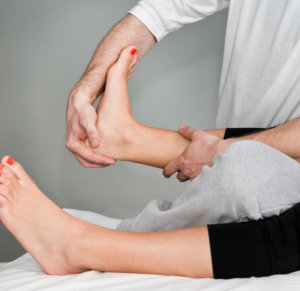Do you treat Achilles Tendinitis at CSC+M?
Yes! We can help you manage Achilles Tendinitis/Tendinopathy so you can recover faster and get back to training.
 Achilles Tendinopathy is a frustrating repetitive stress injury. It usually starts off as the Achilles being sore during a run, then “creaky” after your run, then feeling stiff and achy during walking. Sometimes with this injury a patient will describe heel pain or burning.
Achilles Tendinopathy is a frustrating repetitive stress injury. It usually starts off as the Achilles being sore during a run, then “creaky” after your run, then feeling stiff and achy during walking. Sometimes with this injury a patient will describe heel pain or burning.
Unfortunately, in the clinic we usually see a patient weeks after the initial tendinopathy phase where they keep running on the injured tissue-because they thought it would go away on its own or with a few days rest. At this phase the Achilles tendinopathy is a true Achilles Tendinitis.
Did you know the Achilles tendon is the strongest and thickest tendon in the body?
The Achilles tendon is the strongest and thickest tendon in the body due to the fact it transmits virtually all the forces of toe off during running(up to 3x your body weight).
You are more susceptible to Achilles injury with speed work, uphill work, forefoot strike running style, or switching to a shoe with a lower heel. (These are the things to avoid when starting back to a running program after an Achilles tendon injury)
The cause of pain is actual physical damage to the tendon fibers:
The pain typically starts off as a dull stiffness in the tendon that gradually disappears as you get warmed up. If you continue to train the pain gets sharp and you will be unable to jog even lightly.
Most cases of Achilles tendinitis happen at the midpoint of the tendon about 2-3 inches above the heel. Some cases are insertional Achilles tendinitis where the injury is right off the heel bone. Insertional usually has involvement of the bursae(small fluid filled sac) that can get irritated as well.
Excessive stress causes physical damage to the fibers of the Achilles’ tendon itself.
What is the Treatment and How long does it take to heal?
A treatment plan usually consists of 12 weeks. The initial treatment plan focuses on rest and ice to decrease inflammation. During this time ankle dorsiflexion (ROM), pronation, hip asymmetries, and strength deficits need to be addressed. Book an appointment with one of our NYC chiropractors to diagnose and develop a treatment plan today.
The key factor that needs to be addressed is the collagen fibers or fascia that is injured when the tendon is damaged. If left to its own devices fascia remodels in a disorganized loose structure rather than the smooth organized aligned appearance of healthy tendon fibers.
The exercises—eccentric heel drops:
- Straight leg: standing on a step with both feet perform a “calf raise” at the top of the motion shift all your weight to the injured side and slowly lower your body down dropping your heel below your forefoot. Use your uninjured leg to return to the up position.
- Bent leg variation: same as above however at the top bend the knee then lower yourself down. Remember don’t use the injured leg to return to the up position!
Do these exercises 3 sets of 15 2 times daily for 12 weeks. Once you can do them with no pain add weights(at home you can wear a back pack.
In the office we use this exercise with Graston technique to remodel the fascia and selectively strip away the misaligned tendon fibers allowing healthy collagen to form along the tendon.
What else can you do to decrease healing time?
- Address contributing factors like loss of ankle ROM- foam roll calves and work on dorsiflexion mobilizations.
- Make good decisions on casual footwear.
- Try using a traditional running shoe with a heel lift rather than minimalist or barefoot shoes.
- Consider custom orthotics to normalize your kinetic chain dysfunction.
- Ice after runs
- Use heat to warm up.
When can you run?
You can still run during this 12 week period as long as the Achilles doesn’t flare up, but remember if you push beyond the capacity of the tissue you will re-injure.
